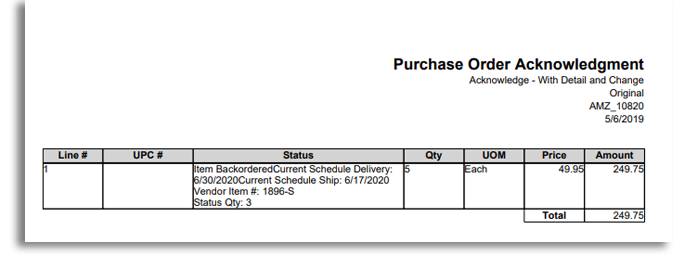EDI 855
Purchase Order Acknowledgement

What is an EDI 855?
An EDI 855 Purchase Order Acknowledgement is an EDI transaction set normally sent by a seller to a buyer in response to an EDI 850 Purchase Order. In addition to confirming the receipt of a new order, the document tells the buyer if the purchase order was accepted, required changes, or was rejected. EDI 855 is often required by large retailers and distributors and may need to be sent in a specified timeframe or at particular step in your order processing workflow to ensure EDI compliance.
This EDI transaction is not meant to take the place of an EDI 997 Functional Acknowledgement but should be sent in addition. EDI 855 notifies the buyer that the order has been both received and processed. Generally, the EDI 855 Purchase Order Acknowledgment includes line item detail about the accuracy of the order and your ability to meet the order’s requirements.
EDI 855 documents follow the x12 format set by the American National Standards Institute (ANSI), a not-for-profit organization that regulates EDI formats in the U.S.
What are the Essential Components of EDI 855?
An EDI 855 document must include key details regarding a new order. These include:
- Details from the EDI 850 Purchase Order, including the PO number and date, product information and accepted quantities, and delivery information
- The seller’s vendor number
- Any changes, errors or issues that need to be addressed, such as:
- Inaccurate product identifiers
- Price discrepancies
- Inventory out-of-stocks
- Delivery date changes
- Backordered or cancelled quantities
- Discontinued items
How Do I Use an EDI 855?
After a seller receives an EDI 850 Purchase Order, they may send an EDI 855 acknowledgement back. The primary use of EDI 855 is to confirm the receipt and processing of a new order and communicate the seller’s ability to fulfill that order. The EDI 855 generally includes reporting of any ordering inaccuracies that have taken place.
In the best-case scenario, an EDI 850 can be accepted as-is, and the EDI 855 is a simple affirmation that the order will move forward. However, if an EDI 850 document contains errors, or cannot be fulfilled as requested, the seller can use an EDI 855 document to alert the buyer to any changes or reject the order entirely.
In response to EDI 855, a buyer will often send back an EDI 997 Functional Acknowledgement, which confirms receipt. If the EDI 855 document specified changes to the order, the buyer has several options; for example, they can send back an EDI 860 Purchase Order Change Request, issue a new EDI 850 Purchase Order or reach out directly to the seller to discuss.
What are the Benefits of EDI 855?
Like all EDI documents, EDI 855 is encrypted in transit to protect seller and buyer details, offering more security than other communication methods. Sending an EDI 855 purchase order acknowledgement eliminates the need to confirm new orders with your customers by email, fax or phone calls. Additionally, the automated nature of EDI 855 helps reduce errors associated with manual retyping and the number of customer service touchpoints.
For buyers, an EDI 855 can quickly alert them to any order issues, preventing any later issues with supply, invoicing, and payments.
EDI Format Example
EDI 855 can be viewed in two formats – a human “readable” version and a “raw” data version. The example below shows the raw EDI data, which is usually translated using integrated EDI software, and then sent to your business system (ERP) to initiate associated workflows.
- Click for Example
-
ISA*00* *00* *12*9622309900 *ZZ*AMAZON *200310* *U*00400*000000113*0*T*>
GS*PR*9622309900*AMAZON*20200310*1315**X*004010
ST*855
BAK*00*AC*AMZ_10820*20190506
TC&*********PO Ack
PO1*1*5*EA*49.95*NT*VN*1896-S
ACK*IB*3*EA*068*20200617
DTM*067*20200630
CTT*1*5
SE*8
GE*1
IEA*1*000000113



